Whether consumers are browsing a website, opening an email from a company they’ve shopped with, or getting served an online ad, chances are a marketer somewhere is hoping their target audience will take very specific actions. One way to get them to do so is through digital marketing design.
Good design is a key component of any marketing strategy. Let’s take a deeper dive into what digital marketing design is, as well as how you can deploy it to keep your customers engaged and satisfied.
What is digital marketing design?
Digital marketing design refers to the visual appearance and strategic approach behind digital assets—particularly how they entice potential customers to take desired actions like making a purchase or signing up for a service.
A good digital marketing strategy is inextricable from good design—according to a landmark McKinsey study, design-forward companies outperform competitors by 2:1. Why? The best design—marketing design or otherwise—solves a problem for the consumer.
When online marketing uses clear calls to action and engaging content, users feel like the work of searching for a product to purchase is done for them. That has a lot to do with the copywriting, but the imagery paired with written content is how you catch your customers’ eyes. Conversion rates rise accordingly.
Elements of digital marketing design
The best graphic design looks effortless. Behind that effortless appearance lies careful attention to proven design elements and principles. All these elements, when combined, create what we recognize as “good design.” When a brand unifies all its visual communication under one brand identity, consumers can easily identify the brand out in the world.
Here are some of the key elements to keep in mind for your own digital marketing design:
- A grid system. The foundation of all graphic design, the grid is a series of invisible and equally distributed lines atop which the rest of the design sits. When designers place elements in alignment with the grid, it’s easier for consumers to visually take them in.
- Alignment. Related to the grid, alignment aids in readability. Graphics should employ consistent alignment—for example, everything should be snapped to the left-most or right-most gridline, or centered.
- Hierarchy and scale. When everything is the same size, we tune out because we don’t know where to look. But when graphic elements are strategically sized—using contrast between very small or very large elements—the design becomes effective in showing us what to pay attention to.
- Color. Choosing brand colors that match the mood of your brand identity and employing color strategically also helps guide the user through your design. Use very dark and very light colors together for high contrast and readability, and use bright or primary colors together sparingly.
- Typography. Typefaces are an effective way to communicate your brand’s personality. Your chosen typeface contributes to your brand voice and helps communicate your brand’s personality. Use unique or statement fonts for large, bold headlines and easy-to-read web fonts for longer chunks of text.
- Images and artwork. Unique brand photography and illustrations help make your designs feel uniquely tied to your brand. Partnering with artists to create your own photography style guide ensures your creation is one-of-a-kind, but purchasing stock assets to populate your designs is functional and budget-friendly.
- Shapes. Something as small as the shape of a digital button (rounded or pointed edges?) can influence the feeling of a design. Organic shapes feel soft and approachable; geometric ones feel precise and bold. Choosing a system of shapes can help convey your brand values and visual identity.
Types of digital marketing design
Each type of digital marketing design serves a unique purpose in your overall marketing strategy. Here are a few real-life examples of how to make the most of each one.
Web design
The homepage and landing pages on any website should be easy for potential customers to engage with: readable, with enticing artwork, pleasing typography, and a navigable interface.
The overall hierarchy and UX of the site should be easy to understand, too—following UX best practices such as keeping the menu along the top of the page, high contrast between typography and backgrounds for legibility, and widely recognizable symbols for actions like search, like, and add to cart. For ecommerce sites, it’s especially important to feature images of your products that convey their quality, style, and utility.
The Momofuku shop’s homepage is a good example of clear, legible type, enticing lifestyle photography, and easy-to-understand product information.

Email marketing design
According to Forbes, email marketing remains the most effective channel for digital marketing campaigns. Email marketing can be used to announce new product launches, sales, and other timely information about what shoppers can expect from a brand.
Email marketing often involves a narrative—whether that’s through a snappy headline, imagery, or words from the head of the company. In this example from Baggu, the design’s emphasis on the product imagery combined with clear discount information helps the user understand that this is a sale they don’t want to miss.

Social media design
Social media marketing is increasingly swaying Gen Z and millennial consumers. Sixty-three percent of Gen Z consumers and 49% of millennials surveyed by Deloitte said ads or product reviews on social media platforms have the greatest influence on their purchasing decisions.
Using social media in new and interesting ways can help a brand stand out from the competition. In this example from Madre Mezcal, a water motif paired with a collage-style homage to Matisse cutouts is cleverly displayed so the individual images form a cohesive image when viewed together on the Instagram grid.

Digital ad design
One of the most ubiquitous forms of digital marketing is pay-per-click (PPC), in which the advertiser pays the host platform every time a customer clicks on an ad. Ultimately, the goal of most pay-per-click campaigns is to gain new website visitors. Ad design varies based on the platform—a website may host banner ads, while ads on platforms like Instagram or TikTok will appear almost like social media posts.
Unlike other types of digital marketing design, pay-per-click ads must be simple and to-the-point while also catching the user’s eye. These ads compete with organic content the user has chosen to see on their social media feed or on a website, so the design should work hard to earn attention. This Megababe ad is effective because it’s ultra-legible, clear, and eye-catching. Everything in the design has a purpose—even the illustrations in the background, which help the customer understand that this is a product for shaving despite its packaging looking more like a face or hair serum.

Content marketing design
One of the most sophisticated marketing strategies to attract new visitors is content marketing. Whether it’s video content, interactive content, or even personalized messages, the best brands reach their target audience by creating something useful and informative that provides valuable information to customers. Some format ideas include blog posts, how-to videos or graphics, quizzes, and games.
This graphic from home goods brand Slowdown Studio combines humor and practical advice, showing customers how to display their signature blankets.

Tips for digital marketing design
- Keep it ultra-simple
- Make your customer feel something
- Consistency is key
- Consider prioritizing brand perception over functionality
There are many ways to make your mark on your brand’s digital marketing design. Here are a few tips to keep in mind as you create your own distinct approach.
Keep it ultra-simple
As a digital marketing designer, you have about a nanosecond to grab your audience’s attention before they’re distracted by the constant onslaught of other images and videos.
In an interview on the Shopify Masters podcast, Jacob Sappington, director of email strategy at growth agency Homestead Studio, spoke about the importance of focusing on one thing. “There’s this thought in the email marketing community: one email, one objective, one call-to-action,” he says. “Make sure if you want your audience to take one action, that button is big, easy to find, and enticing to click.”
This principle extends beyond calls to action (CTAs). “You shouldn’t go from ‘Shop this collection’ to ‘Check out our charity work’ to ‘Check out what our founders are doing,’” Jacob says. Keep it to one clear message per email.
Make your customer feel something
Marketing design is ultimately about getting your customer invested in the story of your product. In ecommerce, you’re likely competing with similar vendors selling similar products. If your marketing design is easy to understand, aesthetically pleasing, and stylistically connected to a larger cultural movement of some sort (a trend, a lifestyle, a generation), your customers are more likely to build an emotional connection with your brand.
Consistency is key
Choosing the same fonts, colors, and styles to use in all your visual communication will help build a strong brand identity that customers begin to recognize. As customers come to associate your digital marketing with a certain visual style, layout, or visual experience when they shop, it gets easier to build brand recognition and even brand trust.
Consider prioritizing brand perception over functionality
A common point of tension that any designer deals with is form versus function. But at Homestead Studio, Jacob says they consider brand perception most important. “Custom fonts are incredibly fickle in email inboxes,” he says.
The solution? Instead of designing emails using live text, Homestead’s designers create the entire email in Figma. Then they slice the design into separate JPGs, linking each slice to the appropriate click destination. Some email marketers disagree with this strategy, worrying that images won’t load, either. But Jacob votes for prioritizing design over perfect delivery, underscoring just how important design is to brand-building.
Digital marketing design FAQ
What is digital marketing design?
Digital marketing design refers to visual choices made in creating digital assets for various channels, including email marketing, social media, pay-per-click advertising, content marketing, and websites.
Is digital marketing like graphic design?
Yes, digital marketing design utilizes principles of graphic design, like color theory, grid systems, typography, and more to create the digital assets we see on our screens every day.
What are the elements of digital marketing design?
The main elements of digital marketing design are similar to the main elements of most types of design: a grid system, alignment, hierarchy and scale, color, typography, images and artwork, and shapes.
How can digital marketing design benefit my business?
Digital marketing design can help build your business’s brand identity and make it easier and more enticing for customers to make purchases. It all adds up to a major business impact. According to a landmark McKinsey study, design-forward companies outperform competitors by 2:1.







